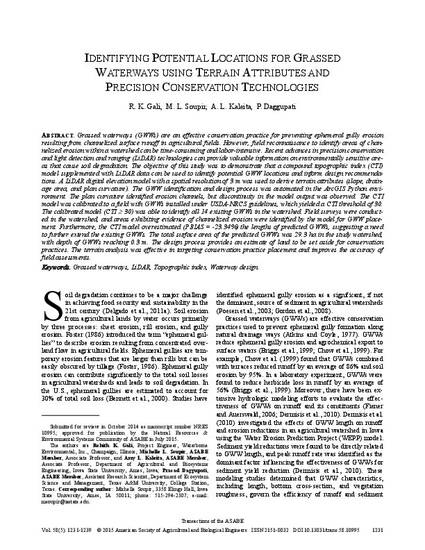
Grassed waterways (GWWs) are an effective conservation practice for preventing ephemeral gully erosion resulting from channelized surface runoff in agricultural fields. However, field reconnaissance to identify areas of channelized erosion within a watershed can be time-consuming and labor-intensive. Recent advances in precision conservation and light detection and ranging (LiDAR) technologies can provide valuable information on environmentally sensitive areas that cause soil degradation. The objective of this study was to demonstrate that a compound topographic index (CTI) model supplemented with LiDAR data can be used to identify potential GWW locations and inform design recommendations. A LiDAR digital elevation model with a spatial resolution of 3 m was used to derive terrain attributes (slope, drainage area, and plan curvature). The GWW identification and design process was automated in the ArcGIS Python environment. The plan curvature identified erosion channels, but discontinuity in the model output was observed. The CTI model was calibrated to a field with GWWs installed under USDA-NRCS guidelines, which yielded a CTI threshold of 30. The calibrated model (CTI = 30) was able to identify all 14 existing GWWs in the watershed. Field surveys were conducted in the watershed, and areas exhibiting evidence of channelized erosion were identified by the model for GWW placement. Furthermore, the CTI model overestimated (PBIAS = -23.34%) the lengths of predicted GWWs, suggesting a need to further extend the existing GWWs. The total surface area of the predicted GWWs was 29.3 ha in the study watershed, with depth of GWWs reaching 0.3 m. The design process provides an estimate of land to be set aside for conservation practices. The terrain analysis was effective in targeting conservation practice placement and improves the accuracy of field assessments.
Available at: http://works.bepress.com/amy_kaleita/52/

This article was published in Transactions of the ASABE 58(5): 1231-1239 (doi: 10.13031/trans.58.10995). Copyright 2015 American Society of Agricultural and Biological Engineers.